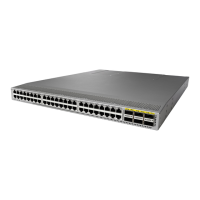Send document comments to nexus3k-docfeedback@cisco.com
3-19
Cisco Nexus 3000 Series NX-OS Unicast Routing Configuration Guide, NX-OS Release5.0(3)U1(1)
Chapter 3 Configuring OSPFv2
Configuring Basic OSPFv2
BEFORE YOU BEGIN
Ensure that you have enabled the OSPF feature (see the “Enabling the OSPFv2 Feature” section on
page 3-13).
Ensure that all neighbors on an interface share the same authentication configuration, including the
shared authentication key.
Create the key-chain for this authentication configuration. See the Cisco Nexus 3000 Series NX-OS
Security Configuration Guide.
SUMMARY STEPS
1. configure terminal
2. router ospf instance-tag
3. area area-id authentication [message-digest]
4. interface interface-type slot/port
5. no switchport
6. (Optional) ip ospf authentication-key [0 | 3] key
or
(Optional) ip ospf message-digest-key key-id md5 [0 | 3] key
7. (Optional) show ip ospf instance-tag interface interface-type slot/port
8. (Optional) copy running-config startup-config
DETAILED STEPS
Command Purpose
Step 1
configure terminal
Example:
switch# configure terminal
switch(config)#
Enters configuration mode.
Step 2
router ospf
instance-tag
Example:
switch(config)# router ospf 201
switch(config-router)#
Creates a new OSPFv2 instance with the configured
instance tag.
Step 3
area
area-id
authentication
[message-digest]
Example:
switch(config-router)# area 0.0.0.10
authentication
Configures the authentication mode for an area.
Step 4
interface
interface-type slot/port
Example:
switch(config-router)# interface
ethernet 1/2
switch(config-if)#
Enters interface configuration mode.

